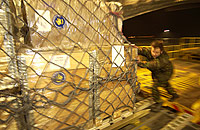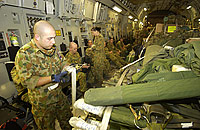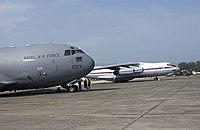
|
|

Latest News Stories
Op Garron: Eyewitness Account of First RAF Humanitarian Airlift
Story by Mike Drewitt, HQ Strike Command
Planning staff from both HQ Strike Command and the Brize Norton-based air transport operations cell had holidays cut short as they planned the movement of crews, freight and passengers around the globe to ensure the swift delivery of resources where required.
Shortly after 2020 on New Year’s day the first of the RAF flights commenced as a Lyneham Hercules captained by Flight Lieutenant Scott Bateman was despatched to Gardemoen Airport in Oslo. The crew's mission was to pick and pre-position, in Denmark, an assortment of emergency supplies and equipment donated by the international Humanitarian Partnership whose member countries include Denmark, Sweden, Norway and Finland. The load also included equipment donated by the United Kingdom and Netherlands.
En route to Norway, a 4-person UK Mobile Air Movements Squadron (MAMS) team from RAF Lyneham and 3-person JATEU team from Brize Norton were dropped off at Billund airport in Denmark to co-ordinate and prepare loads for onward movement to Banda Aceh. In addition, a 4-man UK MAMS team headed up by Sgt Dave Wilson continued to Gardemon to prepare Hercules loads destined for Denmark and a Tristar KC1 load destined for Penang. Through snow showers and temperatures of minus 12 degrees, they worked to ensure that the load was prepared as quickly as possible.
Sgt Dave Wilson, said:
"Working outside in these extremes of temperature was a real challenge but is something that UKMAMS personnel get used to. Knowing that it was for such an important task gave all of the team the added incentive to get the job done."
 At 2020 the same day, I joined a 99 Squadron C-17 as it took off the civilian airport at Billund, which was acting as the distribution hub for equipment destined for use by United Nations personnel as part of their co-ordination and rescue effort. During a two-hour loading operation, the UKMAMS team together with the aircrew loaded generators, vehicles, water purification and other vital equipment. Such was the unusual nature of the load, which included a 22-ton forklift truck, that a Joint Air Transport Evaluation Unit (JATEU) team led by Flight Lieutenant Ruth Harris were on hand to offer specialist advice and guidance. She said:
At 2020 the same day, I joined a 99 Squadron C-17 as it took off the civilian airport at Billund, which was acting as the distribution hub for equipment destined for use by United Nations personnel as part of their co-ordination and rescue effort. During a two-hour loading operation, the UKMAMS team together with the aircrew loaded generators, vehicles, water purification and other vital equipment. Such was the unusual nature of the load, which included a 22-ton forklift truck, that a Joint Air Transport Evaluation Unit (JATEU) team led by Flight Lieutenant Ruth Harris were on hand to offer specialist advice and guidance. She said:
"The weight and profile of the forklift tested the loading limitations of the aircraft and detailed calculations were required to enable it to be restrained safely and securely."
The damp conditions at Billund, along with uncertainty about the forklift’s brakes, led to fears that should it be driven onto the aircraft, it might skid and cause serious damage. The combined expertise of the RAF personnel quickly solved this problem, using the C-17's onboard winch.
With the long leg to Abu Dhabi ahead of us, we returned to Brize Norton fully-loaded with freight, plus a hastily put-together Scandinavian emergency response team who would build and run a UN rescue co-ordination centre in Indonesia. A slip crew took us on to Abu Dhabi, where, after taking on fuel and a second slip crew at the controls, we started the final leg of the journey to Banda Aceh.
 At just after midnight on 2 January, under the watchful eye of the international media - and the Royal Australian Air Force who were providing crucial airfield support - the UK C-17 touched down at Banda Aceh. During the next two hours, and in 65% humidity, RAF personnel and Indonesians worked on the cramped pan - capable of handling only a few aircraft at a time - to clear the 50-ton load into the grateful hands of UN personnel.
At just after midnight on 2 January, under the watchful eye of the international media - and the Royal Australian Air Force who were providing crucial airfield support - the UK C-17 touched down at Banda Aceh. During the next two hours, and in 65% humidity, RAF personnel and Indonesians worked on the cramped pan - capable of handling only a few aircraft at a time - to clear the 50-ton load into the grateful hands of UN personnel.
Although very much a team effort from people across the different trades of the RAF, it was Flight Lieutenant Ian McWilliam who had the privilege to land the first RAF load into the disaster area. Ian said:
"I think it’s hard to get into perspective just how vast the devastation has been and obviously we are very pleased to be part of the crew of the first RAF aircraft to come into this affected area. For us it is very emotional, and just the start of a long process."
Acknowledging the support of everyone who made the mission successful he added:
"A great of planning has been going behind the scenes since the disaster happened and people have been pulling out all the stops at levels within the air force to get the aircraft here as quickly as possible."
39 hours later, after delays due to flight restrictions and a disabled aircraft on the runway, we retuned with a second load which had been delivered earlier to Penang International Airport by the Brize Norton Tri-Star.
On 4 January, at the request of the Royal Australian Air Force, the UK C-17 was re-tasked to deliver urgent supplies to deployed Australian personnel at Banda Aceh. The load, including medical supplies, water and food, was accompanied by RAAF medics and air traffic control staff. As worldwide aid started to arrive in larger quantities, the pressure on air traffic control services at Banda Aceh meant that the Australians were needed to augment Indonesian control staff.
During the operation, on two occasions the C-17 was required to reverse-manoeuvre into- and out-of parking areas – a special technique trained for but rarely used by the RAF crews, until now. Flight Lieutenant Ian McWilliam said:
"In certain airfields there is no facility for pushing back of this aircraft and this is the sort of scenario where the C-17 is absolutely ideal, not only can it carry a vast amount of freight but it can also operate into short airfields where no normal ground handling facilities are available.”
 On 5 January we left Butterworth in Malaysia, arriving at Banda Aceh just one hour later, for our our third and final trip and the first for us in daylight. This revealed the full horror of the Tsunami. From the air, as far as the eye could see, was a scene of utter devastation; the water had carved through villages leaving death and destruction in its wake. On the ground, just a few hundred metres from the military pan where we parked, a football field had been turned into a temporary helicopter landing site. Around us, US Seahawk helicopters ran a constant shuttle of aid out to the far reaches of the region, returning with the most seriously injured wherever they found life.
On 5 January we left Butterworth in Malaysia, arriving at Banda Aceh just one hour later, for our our third and final trip and the first for us in daylight. This revealed the full horror of the Tsunami. From the air, as far as the eye could see, was a scene of utter devastation; the water had carved through villages leaving death and destruction in its wake. On the ground, just a few hundred metres from the military pan where we parked, a football field had been turned into a temporary helicopter landing site. Around us, US Seahawk helicopters ran a constant shuttle of aid out to the far reaches of the region, returning with the most seriously injured wherever they found life.
During the short time we were on the ground, I witnessed four injured and traumatised Indonesians being carried by stretcher from a Seahawk to a nearby field hospital, each one wearing a look of pain, confusion and disbelief. Nearby desperate people – some local, some foreign tourists, looked on waiting for news of loved ones. A US Hercules, engines running, stood by ready to help evacuate the island.
Our arrival coincided with a visit to the region by the International Development Secretary, Hilary Benn, who had been brought to the region in another UK C-17. Spotting our Union flag, he dashed over and spoke to our crew about their current task and what aid they had brought in. Impressed by their efforts, he left for a meeting in the Indonesian capital Jakarta just as our unloading completed.
Then we departed, our load having been removed by the forklift truck we had delivered only a few days before.
Date Last Updated : Friday, January 14, 2020 3:53 PM
[ Current Stories | Events
| Latest Images ]
[ Deployments and Exercises | Aircrew
Retention ]
[ Half-yearly Appointments | Search
and Rescue Statistics ]
[ Equipment | Squadrons
| Stations | Organisation
| Government ]
[ News | Downloads
| History | Links
| Careers ]
[ Home ]
© Crown Copyright 2020-2020 and © Deltaweb International Ltd 2020-2020